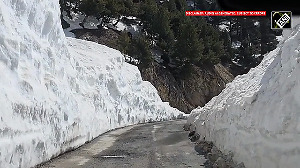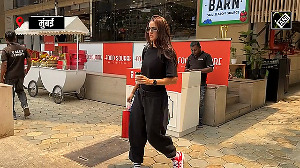While the government insists that the road will help in solving traffic woes, environmentalists and locals decry cutting of trees, impact on environment.

Bengaluru is getting a shiny new steel flyover that will cut through the heart of the city. The tolled road will allow travellers to cover the distance between the airport and the tech hub in seven minutes, claims Karnataka Chief Minister Siddaramaiah.
The flyover, which will cost around Rs 2,000 crore, however, will involve uprooting 812 trees and heritage structures being ravaged. Also, environment experts say the steel bridge would increase the temperature by one or two degrees in India’s coolest city, given that the material absorbs heat and releases it back in its surroundings.
Once known as the garden city, Bengaluru’s green cover has dwindled and it is getting hotter by the day. In the 1800s, the average temperature in summer was 14-16 degrees. Today, it is normal for the temperature to reach 38 degrees.
While the indiscriminate felling of trees to build technology parks, malls and multi-storied offices and residential complexes has shrunk the city’s green zone, the outsourcing and start-up boom has attracted a large number of professionals to the city, adding to its population burden.
There are fewer public buses than required; the metro rail is still in its first phase of implementation and carries only about 160,000 passengers a day; and a three-decade plan for a commuter rail system -- the cheapest solution so far -- has been shelved.
The result is an increase in private vehicles. The city, home to over 11 million people, has 6.42 million vehicles, according to the latest statistics on Karnataka’s transport department site. That is around one vehicle for every two citizens.
Traffic jams, therefore, are a common sight. But the flyover, those who oppose it, say is a short-sighted approach to solving Bengaluru’s long-term traffic problems.
Despite pleas from citizens, however, the government is going ahead with the plan. “Around 73 per cent of the suggestions we have got are in favour of the project. We will thus go on with the construction,” says the chief minister. The Bangalore Development Authority, which claims to have asked for public comments, received 399 responses in all.
An old idea

The idea of the flyover was first floated in 2010 when the Bharatiya Janata Party was in power in the state, but nothing much happened after that. When the Congress-led government in 2013 decided to approve the project, several BJP members opposed it saying the BDA had found the flyover to be non-viable.
“In 2010, when BJP was in power, the idea was brought up by the then BDA commissioner but the plan was scrapped later. BJP has nothing to do with the steel flyover,” says Suresh Kumar, a BJP member of the state assembly. “It will just shift the traffic mess from one corner to another.”
Rajya Sabha Member Rajeev Chandrasekhar says the project is a blatant misuse of public money and even illegal, as the proposal was not placed before the constitutionally set-up Bengaluru Metropolitan Planning Committee. He adds the flyover’s impact study has also not been made public.
Citizens Against Steel Flyover, a collective that has been formed by Namma Bengaluru Foundation, is mobilising people via social media platforms to protest against the flyover. Instead of building a flyover to ease traffic woes, the forum has asked for a suburban railway system using existing rail network; more buses; lower fares; and speeding up work on the metro system.
“The way the chief minister and BDA have responded, saying the project will go on regardless of the opposition, is not a good sign. So many people are protesting against the project. We have around 13,000 people on our Facebook page and 23,500 signatures for our online petition. We want public consultation on the project,” says Sridhar Pabbisetty, CEO, Namma Bengaluru Foundation.
Last week, the government made the project report public under pressure from people. Naresh Narasimhan, an architect from Bengaluru who is spearing heading the Citizens Against Steel Flyover, says, “While we have not looked at the Detailed Project Report, we have already seen a few lapses in it. We will prepare a detailed report and approach the government.”
People are most concerned about the environmental impact the flyover will have. While BDA has said it would plant 60,000 saplings to compensate for the loss of trees, environmentalists are not convinced. They allege the saplings are ornamental plants and will not make up for the trees.
Suresh Heblikar, an environmentalist from the city, says those protesting the project are not against development. “The question that the government needs to answer is: Do we need the flyover or are we making it because we want it? As it is, Bengaluru people are prone to respiratory disorders, these trees are what will keep us away from it. What will our children breathe tomorrow if not for these trees? What are we doing to our city? These are some of the questions the government should think about,” he says.












 © 2025
© 2025